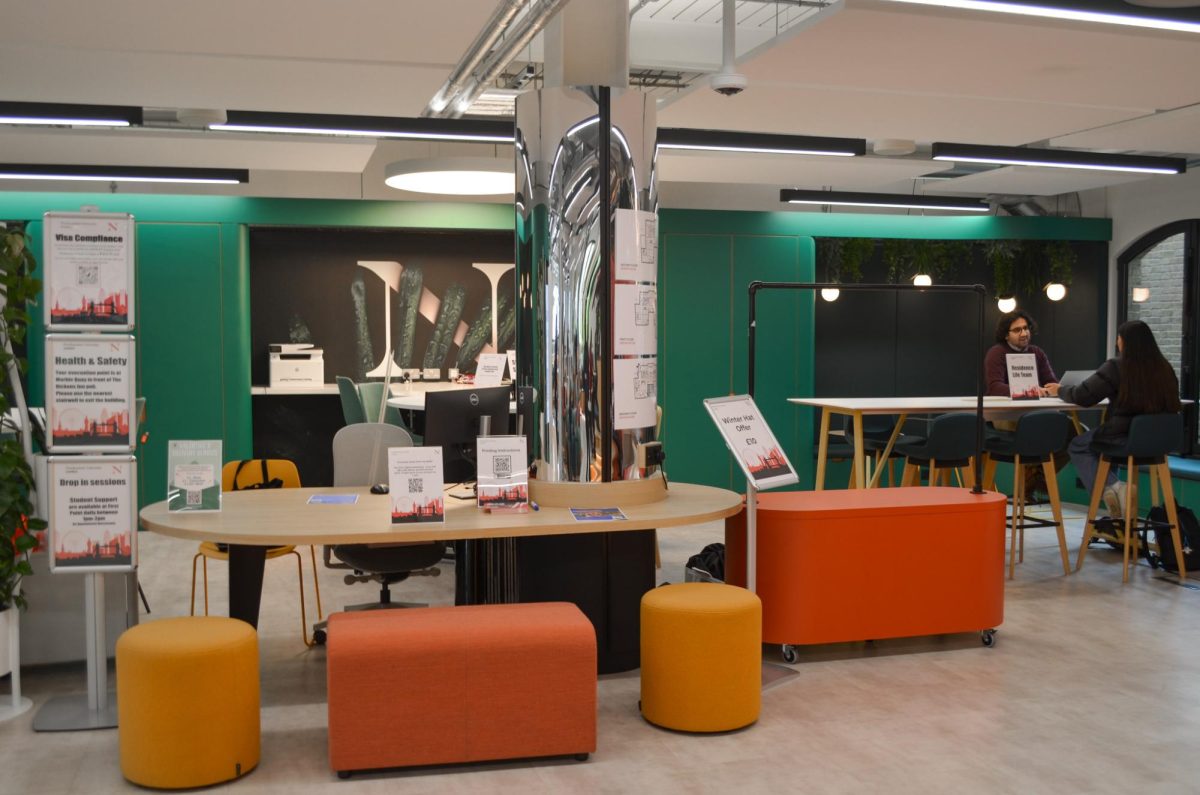Beneath a frenzy of curly hair, a young girl gazes into the distance. She looks serene, calmly surveying the scene.
She stands no further than 10 miles from an Iranian war-zone.
The photograph capturing this moment is featured in “History Recalls And Nothing Has Changed,” the latest art exhibit in the Curry Student Center Art Gallery. It opened Jan. 8 and will run through Jan. 27.
The exhibit originated as a collage of photographs of the Iran-Iraq war taken in 1984 and 1985 by Naveed Nour, an information technology consultant and service management leader at Northeastern who grew up in Iran. Nour, along with three other artists – Rania Matar, Nasser Palangi and Farideh Zariv – said the exhibit’s aim is to combine different perspectives of war and its effects on the human condition.
Nour used photography to document the destruction from the war, and five years later he made a collage of his photographs, showing images of rubble, public demonstrations and the young girl who Nour referred to as his “Mona Lisa.”
“She’s my witness. In a way, it’s almost like it’s from her point of view,” he said.
This first collage was finished in 1990 and earned the title “History Recalls,” a name Nour borrowed from the lyrics of “Fool’s Overture” by British rock band Supertramp. In 1995, Nour made a second collage called “Once Upon A Time,” featuring images of a statue of a woman and a child, children mourning their parents and an empty playground. Both collages are on display at the exhibit.
Palangi, who taught Nour at Tehran University in Iran, collaborated with him on a painting called “The Explosion.” The piece portrays women trapped in a symbolic jail. An explosion from the nearby war-zone illuminates their faces and the jail’s chipped tile.
Palangi’s drawings, many of which feature women, were done during the two years he spent in the war-zone in the late 1980s. He drew using various types of paper, ranging from ruling and packaging paper to tissue paper, dependent upon what he had access to at the time.
He said he hoped to use his art to reach a global demographic.
“I try to use visual language because of the worldwide expression, and because it doesn’t need a translation,” Palangi said. “Everybody can understand this language.”
Zariv, Palangi’s wife, contributed some of the more colorful works in “History Recalls.” She used texture, shapes and contrast to display women affected by the destruction.
The newest work in the exhibit is by Matar. She was in Lebanon with her children July 12, 2006 when the country was attacked by Israel. She fled Lebanon to protect her children, but returned two months later with her camera. She described photographing the war-zone as “overwhelming.”
“I have never seen so much destruction. There’s so much around you,” Matar said. “I ended up photographing what you find in the rubble: people’s lost memories. You find homework, wedding photos scattered in the rubble. And it could be anybody’s.”
Nour said despite a 22-year gap between when he and Matar took their respective photographs, there are few differences in the images.
“Nothing has changed. If you look at some of my photos and put them next to [Matar’s] pictures that she took a few months ago, society would not know which is which,” Nour said.
Nour, his wife, Zohreh Firouzabadian, and Director of Operations at the Curry Student Center Robert Grier worked to bring the exhibit to campus. Grier said the exhibit was important because it showed a Northeastern staff member’s talent and helped people understand the war from a different perspective.
“I think it’s very good to show that side of war,” Grier said. “We’re at war right now, and Iran is on the frontline of people’s thoughts.”
Firouzabadian, who is in charge of marketing and promotion for the exhibit, met with Grier to explain its vision and arrange the logistics behind the gallery’s visit.
“I want to create awareness and also to share the story amongst those who have and have not experienced war and oppression,” she said. “It’s to create a forum for communication.”
Firouzabadian contributed to one piece of the exhibit. Located in the center of the gallery are a broken picture frame, a cracked CD and other wartime artifacts arranged to resemble a pile of rubble. Matar’s vibrant photographs of rubble surround the pile.
Matar said she used the beauty of her art to leave a lasting impression on viewers.
“I think it’s a very touchy question, how to make something beautiful out of someone else’s misery,” she said. “But when you make something beautiful, it makes people look at it and remember it.”
Students at the exhibit said they were impressed by the images.
Martin Lenon, a sophomore business major, said the exhibit was important because it allowed students to see a society that they never knew existed.
“It’s a totally different culture, something I’ve never seen before,” Lenon said. “And it’s all war-torn. You can definitely feel it.”
There will be a presentation at the exhibit tomorrow at 7 p.m. The hour-long session will feature a gallery talk, a slide show and a short documentary by Palangi’s son, Amin. Nour, Palangi, Matar and Firouzabadian will be present at the session.
Nour said he hopes the exhibit will broaden students’ outlooks on the effects of war beyond what’s seen on traditional media outlets.
“The whole purpose of ‘History Recalls’ is to bring awareness to people and help them express their feelings,” Nour said. “We are at war with Afghanistan and Iraq but as regular citizens we don’t feel it; we see a little bit of it on TV and newspapers. This should bring awareness to people.”









